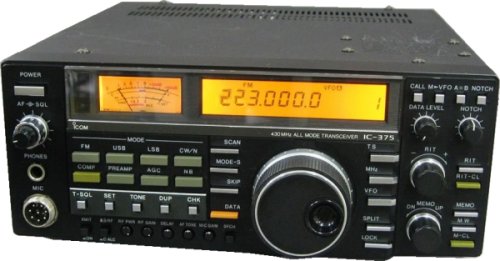ICOM IC-375A 220-MHz Multimode Transceiver
- Manufactured: Japan (Discontinued)
It's finally happened. The diehard 220 enthusiasts can now rejoice and revel in ICOM's latest entry into the VHF/UHF multimode market: The IC-375A transceiver. It's made exclusively for the North American amateur market.
Similar in design and operation to the IC-275 and IC-475, this radio offers a wealth of features for everyone, from the casual FM operator to hard-core packeteers. Considering this is the first time any company has manufactured such a transceiver, one has to be impressed with the sophistication of the design.
Overview
The front panel. Note the virtually identical copy of its sister transceivers for 2m and 70cm. The bright, backlit amber LCD display jumps out, showing frequency, VFO_t memory channel, RIT, tone squelch, duplex offset, and mode. The frequency selection dial sits beneath the display, and has silky-smooth operation over a variety of tuning increments.
Modes
The 375 has four modes: FM. LSB, USB and CW, Pushing the CW mode switch again enables the optional CW filter (500 Hz)_r which the operator can use in conjunction with the Passband Tuning (PBT) and Notch controls for enhanced selectivity Provision is made to switch a tower-mounted preamplifier from the front panel (maximum power: 100 watts) as well as to enable a built-in speech compressor. There are also two speeds of AGC selection.
The user can select sub-tone frequencies on both receive and transmit, and store any combination of offsets, sub-tones, modes and frequencies in 99 seperate memory channels—more than adequate for everyday use. Two priority channels are also available which store similar data.
RIT (Receiver Incremental Tuning) is standard and permits a shift of up to 9.9 kHz either side of the displayed frequency. The RIT can be cleared to zero offset at the touch of a button. This feature works in all modes, including FM.
Additional controls set up the microphone gain (not deviation), RF output power, RF gain, CW keying delay, meter display, and AF tone quality from the built-in speaker. The AF gain and squelch controls are located to the right ol the display meter, directly below the main power switch, in order not to confuse them with any other controls.
Several scan rates are available. The standard band scan is incorporated, along with programmable range scanning, se~ lectable mode scanning through memories, and general purpose memory scanning A skip button allows the operator to lock out undesired channels when in scan mode. When using the programmable scan function, transmitting or touching the main tuning dial erases the preprogrammed band limits.
As on all new ICOM muftimod-es. the 375 has full break-in keying (QSK). Current activity levels are presently too low for QSK to be really useful now. In many cases also, full break-in keying isn't usable due to sequenced switching of amplifiers and external preamplifiers. The optional AG-30 mast-mounted preamplifier won't function when full QSK is selected either Semi break-in is also available with the drop-out delay set from the front panel. Note that no VOX operation is available—none of the new 75 series transceivers offer it.
The DATA switch on the 275**and 475 is also available here. ICOM claims a switching time of less than 5 milliseconds, which should be ideal for packet operation. Packeteers will not be able to use an external amplifier or preamplifier, however, due to this rapid switch time. The IC-375 also runs AMTOR. conventional AFSK RTTY, and SSTV.
